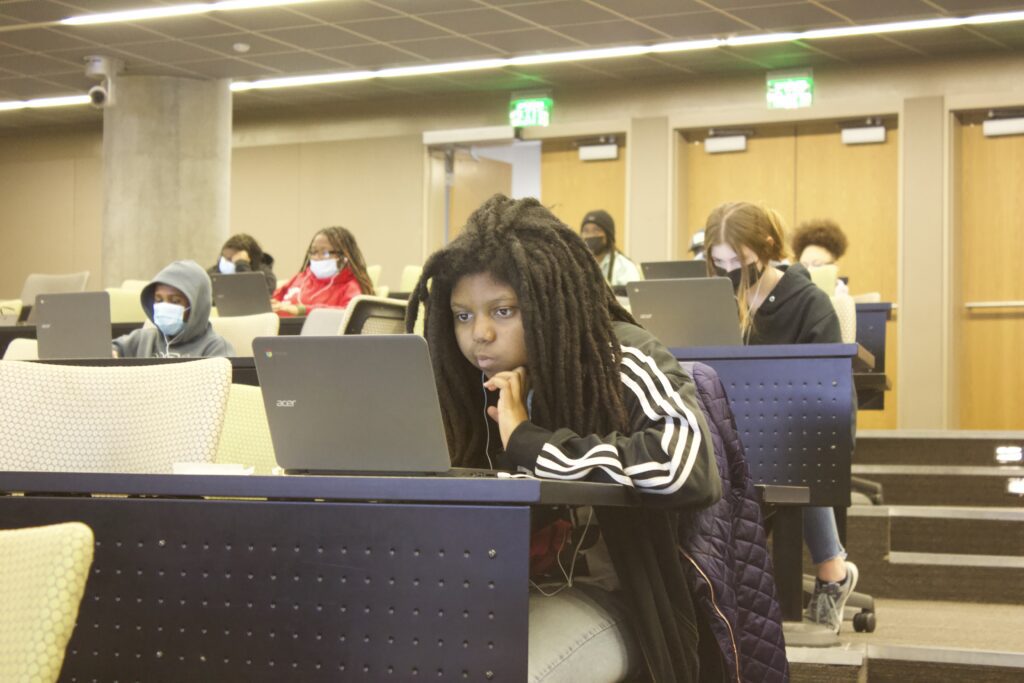
The Student-Centered Computing curricula focus on building student agency in multiple ways. The curricula are designed so that students can develop a sense that they can, through their actions, effect some change in others or impact a situation. The extended PBL arc allows students to focus on how to learn and then educate and advocate audiences around a specific issue using their computer science skills. Creating digital products and solutions related to the problem they care about provides them with an ability to use computer science skills to address real-world needs and problems, helping them change the world into one that they view as more just.
Student-Centered Computing emphasizes the skills, knowledge, perspectives and strengths present already in students, their groups and communities. Students select problems relevant to their personal, social or cultural experiences and work to make sense of these problems from both research and storytelling perspectives. This emphasis on storytelling, as opposed to having an emphasis on “facts”, enables students to incorporate their own personal stories and culture into their digital products. The use of EarSketch to engage musically and communicate to audiences also capitalizes on students’ creativity, multiple skills and out-of-school funds of knowledge and engagement with musical forms. Students also build a resume, sequentially adding new skills to the resume and reflecting on the strengths, or assets, that they bring to the project. By the end, students have explored multiple different types of roles involved in computer science-based careers and reflected upon their own interests and talents.
Skillfully facilitating group work to support and engage all students requires care and practice by teachers. Student-Centered Computing is designed to provide a context for collaborative learning experiences that increase equity in the classroom. Students continually work in groups and have the opportunity to try on multiple roles related to different computer science skills. Some of these roles, such as Server Administrator, Layout Designer, Project Manager, and Quality Assurance Manager, are defined within the curriculum and rotated among the students. In addition, the curriculum offers continuous opportunities for students to engage in collaborative work-like pair-programming, and teacher-facilitated peer-feedback.
There are several interventions threaded through Student-Centered Computing that explicitly address issues of stereotype threat. Students’ incremental views of their computer science skill acquisition and knowledge growth are strengthened by having them explore different roles in computer science as they create their products and document their increasing skills through reflection in their resume and portfolio. After being engaged in seamless programming activities, students engage in discussions about “Who is a Coder?”, which enables them to envision themselves in that role. In addition, the curriculum provides video interviews with students of color who are successful computer science majors. These college students discuss the challenges they have faced, and how they were able to overcome them, which provides with relatable role model examples to students in the course. The focus on exploring computer science careers and the skills students have and would need to gain also allows them to envision a “future self” in computer science.
As students create their design visions, and particularly when they analyze the audience for their products, they engage in scaffolded activities that promote empathy and that require that students consider the perspectives of others with regards to their focal problem, its impact, and the products they create. Empathy is also stressed as students learn to provide constructive feedback to peers.
As students create their design visions, their websites, and their games, teachers are prompted to engage the class in critical discussion surrounding computer science issues. Some might include an exploration of students’ assumptions, and audience considerations—i.e. who is included as part of the audience, and who is excluded or forgotten. Images that are included on websites and in games also provide avenues for discussions about how people are represented and misrepresented, the ramifications of stereotypes, and how images on social media and search engines influence and manipulate audiences.
Center for Education Integrating Science, Mathematics, and Computing (CEISMC)
Georgia Institute of Technology
505 10th St NW
Atlanta GA 30332-0282
https://ceismc.gatech.edu
Ph: 404-894-0777
Fx: 404-894-9675
Georgia Institute of Technology
North Avenue, Atlanta, GA 30332
404.894.2000
Legal & Privacy Information
Human Trafficking Notice
Title IX/Sexual Misconduct
Hazing Public Disclosures
Accessibility
Accountability

© Georgia Institute of Technology